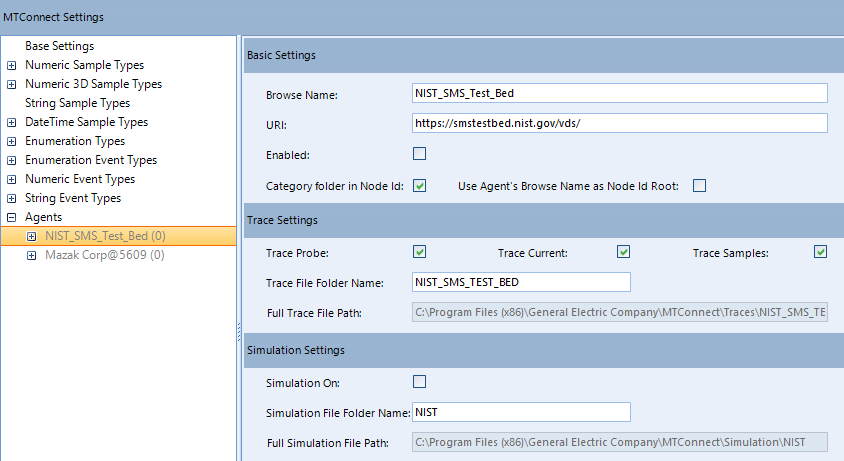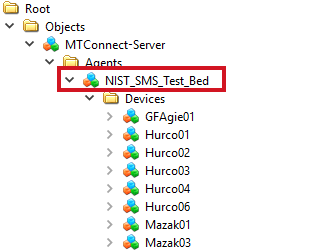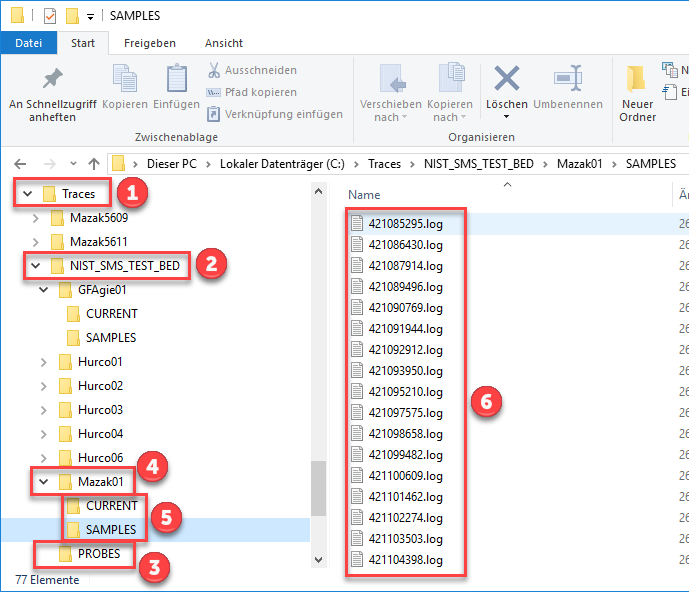Agents

Browse Name
This name is used as browse name in the OPC UA client browse tree. The Browse Name has to be unique, means no other agent of the configuration can use the same name. The following screen shot of an OPC UA Client browser window shows the agents browse name (marked with the red box) within the browse tree:

URI
The URI of the MTConnect agent. When Simulation is enabled then the URI can be left blank.
Enabled
The driver processes (connects to) this agent only when it is set enabled.
Category folder in Node Id
If checked, the server extents the node id path by the category field for the three data item categories SAMPLE, EVENT and CONDITION.
The following two pictures show OPC UA node Ids, the upper picture with category field, the lower picture without category field:

Node Id with data item category field

Node Id without data item category field
Using the category field in the node Id is mandatory for configurations where the same MTConnect type name is used for data items in different categories.
Use Agent's Browse Name as Node Id Root
If checked, the server uses the agent's browse name as node Id prefix, means the OPC UA node identifier string starts with the agent's browse name. This setting is required if multiple agents use the same device names (attribute name of a XML element Device in Probe response). To distinguish equal device names of different agents in the OPC UA node name space, the agent's (browse) name is used as root of the OPC UA node identifier.
The following two pictures show OPC UA node identifiers with and without leading agent browse name:

Node Id with data item category field

Node Id without data item category field
Trace Settings
- Trace Probe
When checked, all Probe responses are saved the trace file folder. The trace file name is built from the prefix "Probe", the time stamp and the file extension ".log".
- Trace Current
When checked, all Current responses are saved in the trace file folder. The trace file name is built from the last sequence number of the Current response and the file extension ".log".
- Trace Samples
When checked, all Sample responses be saved in the trace file folder. The trace file name is built from the last sequence number of the Sample response and the file extension ".log".
- Trace File Folder Name
An agent-specific sub-folder for the trace files. The trace file root folder is specified in the Base Settings.
- Full Trace File Path
This read-only field shows the full trace file folder path, which is the combination of trace file root folder and the agent specific trace file folder name.
- Example trace folder structure
The following figure shows the folder structure for the NIST-SMS-Test-Bed Agent.

 The Trace File Base Folder.
The Trace File Base Folder. The Agent-related Trace File Folder (See
2.2.1).
The Agent-related Trace File Folder (See
2.2.1). The Folder PROBES for the Probe responses of the Agent.
The Folder PROBES for the Probe responses of the Agent.
 The specific folder for a single MTConnect device. The name of the folder is
derived from the value of the “name” attribute of the “Device” element of
the MTConnect Probe XML response stream.
The specific folder for a single MTConnect device. The name of the folder is
derived from the value of the “name” attribute of the “Device” element of
the MTConnect Probe XML response stream. The folders
CURRENT and SAMPLE for the Current and Sample trace files of a
specific device.
The folders
CURRENT and SAMPLE for the Current and Sample trace files of a
specific device. The file names of the Current and
Sample trace files are derived from the “next sequence” attribute
of the “Header” element of the MTConnect Current or Sample XML
response stream.
The file names of the Current and
Sample trace files are derived from the “next sequence” attribute
of the “Header” element of the MTConnect Current or Sample XML
response stream.
Simulation Settings
- Simulation On
When checked the driver doesn't try to connect to the agent's URI but reads the Probe, Current and Sample responses from XML files
- Simulation File Folder Name
An agent-specific sub-folder for the simulation files. The simulation file root folder is specified in the Base Settings.
- Full Simulation File Path
This read-only field shows the full simulation file folder path, which is the combination of simulation file root folder and the agent specific simulation file folder name.